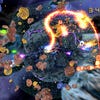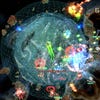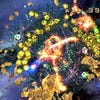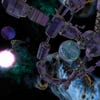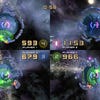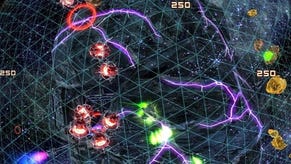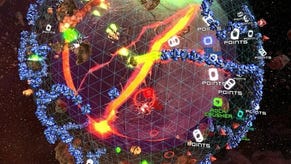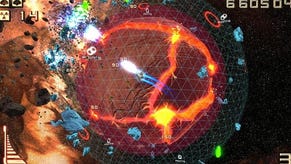Digital Foundry vs Super Stardust Ultra on PS4
Port, sequel, or something in-between?
This week's release of Super Stardust Ultra on PlayStation 4 amounts to more than a simple port of the Housemarque's twin-stick classic - a game already running at full HD and 60 frames per second on PS3. A full eight years later, new developer D3T takes the call to make an updated version, adding new modes and visual enhancements along the way - but given that the game already stood as an effects and physics showcase on last-gen, just how much more does the Ultra edition add?
First off, it's worth pointing out that while the the PS4 title is not a direct port of the excellent Super Stardust HD on PS3, it's fair to say that the vast majority of the original game's rendering underpinnings are transferred across with only a modicum of improvements bearing in mind the generational leap in hardware spec. Similar to the fully patched last-gen release, Ultra runs at true 1080p with a 60fps target - enhanced with 4x multi-sampling anti-aliasing on some surfaces - with rare support for stereoscopic 3D maintained in this new release too. [UPDATE 13/2/15 17:00: Reviewing the assets, it looks like Ultra actually deploys 4x MSAA as opposed to a post-process solution, though some of the effects work appears to compromise the effect.]
This is essentially the full PS3 release, bolstered by new modes to make more of the PS4's feature-set. Chief among them is interactive streaming, a broadcast-based survival mode allowing spectators to impact your run via votes - either opting for boosts to aid you, or a spike in enemy spawns to make life more difficult. Given the console's focus on social features, it's a nice touch, though a bona fide online multiplayer mode would have been more welcome here. Other additions could have easily made the cut on PS3, such as the rudimentary ship editor, or the simpler single-player modes such as Impact and Blockade.
Visually, it's a familiar setup for the engine, where physics, collisions and LOD management lean heavily on the PS3's multi-SPU design of the Cell processor. Despite the move to a more conventional multi-core CPU setup in PS4, it doesn't dial back these dynamics; asteroids still crumble into a minefield of tinier chunks, spinning independently across the sphere. It's still Stardust in all its spectacular, physics-driven chaos, though now with a few extra visual treats.
It mostly differs in terms of presentation. The PS4 edition's five stages sport more visually complex planets, each renamed to reflect the switch, with noticeably sharper texture maps wrapped across each. It's an aesthetic change only, but often an impressive one compared to the flatter, simpler world designs on PS3. The fiery second stage in Ultra, for example, adds a giant rift to the planet's centre, bridged by man-made structures at a level of detail we haven't seen before from the series.
It's easy to be misled by this, though. As each stage progresses, it's clear that the timing of each enemy wave is plucked directly from the PS3 release, leading right up to the same end bosses. It's essentially a re-skin of the older experience, albeit one that utilises the PS4's stronger GPU to justify a visual refresh. The opportunity to dig deeper, and perhaps design entirely new enemies from scratch, is missed here - something that could easily have reshaped the gameplay experience. Instead, the familiar flying saucers and centipedes of the PS3 edition spawn back in.
This is also the case for Super Stardust Ultra's other visual tweaks; all style, but short on true, substantial change to gameplay. Another example is in its extra details around each planet, such as debris, orbiting moons, asteroid clusters and space stations. The PS4 pushes for fully geometric elements that gravitate around the action, though entirely for show, as opposed to the simple sea of stars used before on PS3.
Sony's last-gen machine was sparing on this front (with just the odd asteroid here or there), but resources were mostly committed to rendering the scores of asteroid chunks on the planet itself. This time, the overhead on PS4 is evidently high enough to embellish the game - though it's unfortunate that the flat, low resolution cloud effects don't receive any extra attention.
But what else is new? In the maelstrom of exploding bomb barrels and spinning rocks, the PS4 advantage is also shown in its effects. Higher resolution particles fire out from exploding enemies now, no longer showing the slight blurring to each speck. Lengthy, coloured trails are also added behind the ship, helpfully indicating which weapon is loaded at the time - though the vivid effects-work on the gold melter, rock crusher and ice splitter guns remain visibly identical to their PS3 counterparts.
To tally the upgrades, Super Stardust Ultra brings new planet designs, more complex background details, and better effects. It's undeniably an improvement, proudly shown off with stylish camera fly-by sequences at the start of each stage - but has this taken a toll on performance in the process?
What we see in Super Stardust Ultra is a 60fps target that is met at almost every moment, creating the silky smooth controls needed to keep up with its bullet-hell challenge. The only drawback on PS4 is a slight increase in the rate of one-off frames dropped; very infrequent mini-stutters that don't manifest to the same extent on PS3. It's a nitpick perhaps, but one that doesn't distract outside of a few instances.
In close analysis of split-screen modes, the same applies for four-player competitive games - 60fps is the dominating read-out, and likewise for co-op in arcade mode. Only occasionally do we see any blip below, triggering a singular dropped frame when a bomb wipes out all ships at once. The two-player co-op is also resilient in this area, capably processing twice the vertices to support these two separate points of view, and rarely skipping a beat. Returning to the PS3 game, single-player and two-player split-screen modes operate at 1080p, but there's clear evidence of upscaling artefacts on the four-player option - this is not an issue for the PS4 title, rendering at full HD throughout.
Despite the PS4 already playing host to the visual fireworks of Housemarque's follow-up title, Resogun, this new version of Super Stardust still holds up well as a current-gen release. Certainly, at its core this is the PS3 edition with a few well-placed visual tweaks, but given that the original remains beautiful in motion even today, the improved effects and scenery - not to mention the new arcade modes - help to make it the definitive release.
Perhaps the only reason we aren't completely blown away by the new PS4 edition is that its predecessor - running on far less capable hardware, remember - is still handing in a broadly equivalent experience. While Ultra is an improvement, it's fair to say that it isn't a game-changer. The fact that its visuals still impress only goes to show just how much of a marvel the PS3 version was for its time.
Overall, at a current download price of £10/€13, the cost of admission is perhaps too high for owners of the original Super Stardust HD, where in purely gameplay terms, the Ultra edition essentially adds an expansion pack's worth of new modes. However, the 20 per cent discount for PlayStation Plus subscribers could tip the balance [Update 13/2/15 15:32: correct prices inserted, apologies for the confusion]. Fresh newcomers will be better served of course, but it's a shame existing fans can't access its new modes and visual tweaks at a discounted rate. Equally, we're surprised Sony's new hardware isn't shaking the Stardust formula more radically than we're seeing here - a challenge in design that we hope original developer Housemarque will rise to as the generation continues.



